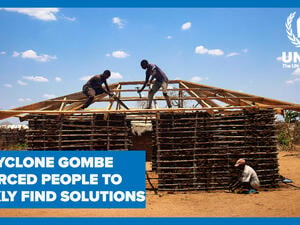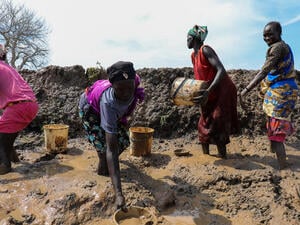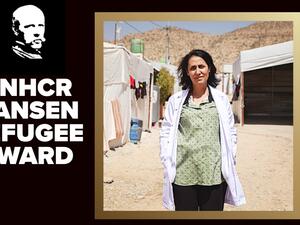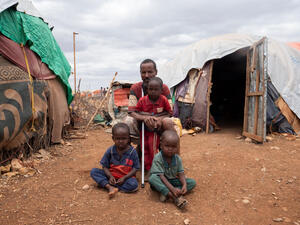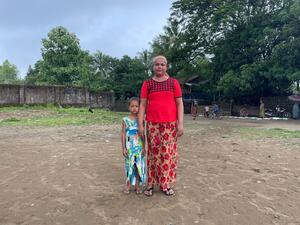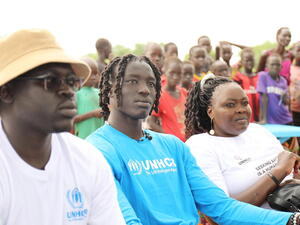DRC: Reports of burning and looting of IDP camps; HC's appeal; arrivals in Uganda and Rwanda
DRC: Reports of burning and looting of IDP camps; HC's appeal; arrivals in Uganda and Rwanda
UNHCR has received disturbing reports that several camps for internally displaced people near the North Kivu town of Rutshuru, about 90 km north of Goma, have been forcibly emptied, looted and burned. We're in the process of trying to verify these reports, which we received from some of our humanitarian partners. We are extremely concerned about the fate of some 50,000 displaced people living in these camps, which include the UNHCR-administered sites of Dumez, Nyongera and Kasasa as well as several makeshift settlements. The area around Rutshuru, where UNHCR has an office, has been the scene of fighting in recent weeks and is now under rebel control. We are trying to verify these reports, but security continues to hamper our efforts.
High Commissioner António Guterres has again appealed to all sides in the conflict to respect humanitarian principles and to ensure the safety of civilians and those trying to help them. "Hundreds of thousands of people who have already suffered far too much are in danger and in desperate need of help," Mr. Guterres said this morning. "As humanitarians, our job is to get life-saving assistance to them as quickly as possible. We are trying to do this in an extremely volatile environment characterised by reported widespread human rights abuses and general lawlessness. While we will do everything we can to help the innocent victims, the solution has to be political and we appeal to all sides to bring this conflict to an end."
In Goma, the provincial capital of North Kivu, a UN team is trying to make its way to Kibati, about 10 km north of the city, to check on reports that some of the 45,000 displaced people who fled two camps there were now beginning to return. The previously uprooted people in Kibati fled again in panic on Wednesday as rebel forces approached Goma. (Note: the joint UNHCR, WFP, Unicef team subsequently reached the Kibati IDP sites and reported that displaced people were once again jamming the sites, which appeared more crowded than ever. The UN was distributing emergency aid.)
UNHCR staff in Goma this morning reported the situation calm but tense. Our office is open and our people are working, but security restrictions on movement remain tight.
Many Congolese fleeing the fighting north of Goma have headed towards Uganda looking for safety. Since the latest round of fighting started in August more than 8,500 refugees crossed the border into Uganda - some 2,500 of them over the past three days, according to reports from a UNHCR team at the border in Busanza, Uganda. Some 600 refugees arrived so far this morning. Many said they had walked for more than 20 hours from the Rugarama area in Congo, some 17 km from the Uganda border.
Most of Congolese refugees in Uganda are dispersed in a dozen villages along the border with the DRC. They are accommodated by host families, friends or relatives. Their condition is presently good, but we fear that the situation could soon deteriorate if medical, water and sanitation facilities are unable to cope with rapidly increasing needs. Logistics are difficult in this remote area. In addition, food supplies in this part of Uganda generally depend on local food imports from the neighbouring DRC.
UNHCR Uganda is working on setting up of a small transit centre in Kisoro town for Congolese refugees willing to move to Nakivale refugee settlement, some 350 kilometres inside Uganda. So far, more than 2,000 newly arrived refugees from the DRC have found shelter and assistance there.
Meanwhile, some 1,200 refugees fled to Rwanda and spent Tuesday in a school in Gisenyi. They did not want to be registered by UNHCR and transported to the transit centre. Our team distributed assistance. On Wednesday when our field workers returned to the school to carry out more comprehensive assessment of the needs - most of the refugees have already either returned to Goma to check on their properties and families left behind or have moved in with their relatives in Gisenyi. We were also informed that some of the refugees crossed the border to Uganda
It's clear that we are going to require more funding to cope with the new needs. We need to rapidly distribute plastic tarpaulins, blankets, sleeping mats, jerry cans, buckets, mosquito nets, kitchens sets and sanitary material and it appears we'll have to set up new sites for displaced people as well as existing camps in North Kivu.
There are 16 UNHCR-assisted sites in North Kivu sheltering some 100,000 people, plus more than 40 makeshift encampments housing tens of thousands of civilians. Altogether, there are more than 1 million internally displaced people in North Kivu.

